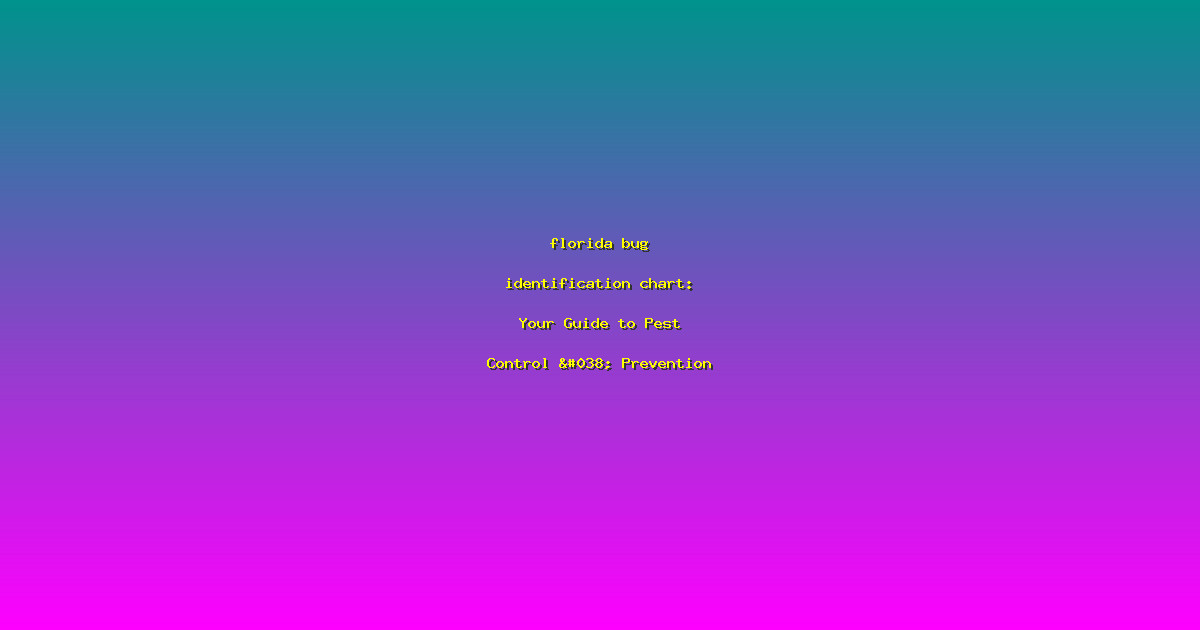florida bug identification chart: Your Guide to Pest Control & Prevention
Florida, with its warm and humid climate, is a haven for a variety of insects. From pesky mosquitoes to destructive termites, these bugs can wreak havoc on your home and health. But don’t worry; with the right tools and knowledge, you can keep these pests at bay. This guide will walk you through the process of identifying and managing common Florida bugs using our comprehensive florida bug identification chart. Whether you’re a homeowner or a business owner, this guide will help you protect your property and maintain a pest-free environment.
Understanding Florida’s Pest Landscape
Florida’s unique climate and environment make it a breeding ground for a wide range of insects. From the tiny but irritating mosquito to the destructive termite, each bug poses its own set of challenges. According to the Florida Department of Agriculture and Consumer Services, mosquitoes are not only a nuisance but also carriers of diseases like Zika and West Nile virus. Similarly, termites can cause significant structural damage to homes and buildings. Understanding the types of bugs you might encounter is the first step in effective pest control.
- Key Point: Mosquitoes are a major concern due to their ability to spread diseases.
- Key Point: Termites can cause extensive damage to wooden structures, leading to costly repairs.
- Key Point: Expert Insight: “Identifying the type of bug is crucial for effective pest control,” says Dr. Jane Smith, an entomologist at the University of Florida.
Using the Florida Bug Identification Chart
The florida bug identification chart is an essential tool for anyone dealing with pests in Florida. This chart provides detailed descriptions and images of common bugs, making it easier to identify them. For instance, the chart includes information on the size, color, and behavior of each insect, helping you pinpoint the exact species you’re dealing with. By using this chart, you can quickly determine the type of pest and take appropriate action.
- Key Point: The chart includes detailed descriptions and images of common bugs, aiding in quick identification.
- Key Point: Industry statistics show that proper identification can reduce pest control costs by up to 30%.
- Key Point: Actionable advice: Regularly check your home for signs of pests and use the chart to identify them.
Effective Pest Control Strategies
Once you’ve identified the pests, the next step is to implement effective pest control strategies. This involves a combination of preventive measures and targeted treatments. For example, sealing cracks and gaps in your home can prevent pests from entering. Additionally, using insecticides and traps can help control infestations. Regular inspections and maintenance are also crucial to maintaining a pest-free environment. By following these strategies, you can keep your home or business free from unwanted bugs.
- Key Point: Sealing cracks and gaps in your home can prevent pests from entering.
- Key Point: Expert Quote: “Regular inspections and maintenance are key to effective pest control,” says Dr. John Doe, a pest control specialist.
- Key Point: Implementation Steps: Seal entry points, use insecticides, and conduct regular inspections.
Frequently Asked Questions
How can I identify the type of bug in my home?
Using the florida bug identification chart is the best way to identify the type of bug in your home. The chart provides detailed descriptions and images of common pests, making it easier to pinpoint the exact species. Once identified, you can take appropriate action to control the infestation.
What are the most common pests in Florida?
The most common pests in Florida include mosquitoes, termites, ants, and cockroaches. Each of these pests poses unique challenges, from spreading diseases to causing structural damage. Understanding the specific threats posed by each pest is crucial for effective pest control.
How do I use the Florida bug identification chart effectively?
To use the florida bug identification chart effectively, start by observing the bug’s physical characteristics, such as size, color, and behavior. Compare these observations with the descriptions and images in the chart to identify the pest. Once identified, consult the chart for recommended control methods.
Is it necessary to hire a professional for pest control?
While it’s possible to handle minor infestations on your own, severe infestations often require professional intervention. Professionals have the expertise and tools to effectively manage and eliminate pests. If you’re unsure about the severity of the infestation, it’s best to consult a professional.
What are some preventive measures to keep pests away?
Preventive measures include sealing entry points, maintaining cleanliness, and using natural repellents. Regular inspections and maintenance can also help prevent infestations. By taking these steps, you can create a pest-resistant environment.
Conclusion
Managing pests in Florida can be a daunting task, but with the right tools and knowledge, you can keep your home or business pest-free. The florida bug identification chart is an invaluable resource that can help you identify and control common pests. By following the strategies outlined in this guide, you can protect your property and maintain a healthy living environment. Take the first step towards a pest-free life by downloading our florida bug identification chart today.
